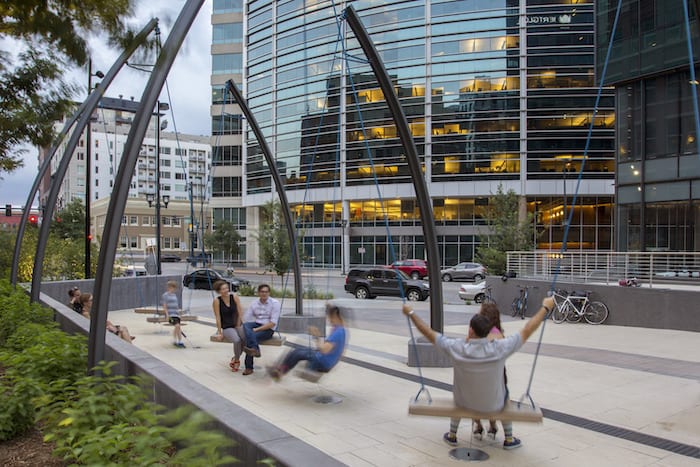The Evolution of Denver Plazas, Private to Public

BUILDING DIALOGUE
In the early 1980s, a development trend made popular in Chicago and New York, known commonly as the “plaza bonus,” made its way to Denver. This tower-in-a-park philosophy was created in larger cities to encourage developers to provide useable public space at the street level by providing incentives allowing buildings to exceed heights and square footage limits, typically governed by zoning. While great in concept, the execution of these plazas lacked an understanding of how people use public space and resulted in lifeless spaces devoid of comfort and activity. Rather than designing plazas as quality public spaces that drew building occupants to the outdoors, they were formal, polished spaces designed for building tenants to pass through on the way to the office.
Fast forward to 2019. When you look up and down 17th Street in Denver’s Financial District, you see a number of plazas in need of renovation to function as contributing public spaces in a downtown short on quality open space. Most of the plazas are empty spaces with no shade canopy and lack programming to make them truly attractive and functional.
Metropolitan areas across the nation commonly strive to provide 10 acres of parkland for every 1,000 residents. According to the Outdoor Downtown plan, a report by the Denver Parks and Recreation Department and the Downtown Denver Partnership, downtown Denver currently has 5.7 acres of park space per 1,000 residents (according to Denver.gov). Space constraints and the high costs associated with land acquisition make it challenging for planners to achieve the goal of accessible quality, publicly owned, outdoor space available within a three-minute walk and a neighborhood park available within a five-minute walk.
One of the solutions to Denver’s lack of publicly owned outdoor space in downtown is to activate these publicly accessible, privately owned plazas. It’s time to encourage collaboration between public officials and private property owners to develop guidelines to improve the quality and accessibility of open spaces in private developments, including private plazas, activated alleys and other open spaces. There are a number of existing private plazas throughout downtown that are serving no active purpose. With some key improvements, these spaces could become lively public outdoors spaces for the community to use.
The best activated plazas are places where people want to spend time. They provide human comfort. They are a place where a team can take their meeting outside, a person can work on a laptop on a nice spring day and coworkers can socialize after work. Programming is a critical element to activating plazas. Quality plazas include amenities that make parks enjoyable – shelter from sun and wind, food and beverage kiosks, seating options, and the addition of extensive plantings – and allow for use across all seasons. Strategic site planning and landscape design, including fixed-shading devices and placement of trees to provide shelter from winter winds, is critical to creating an inviting public outdoor space. Moveable furniture, hammocks and lawn games allow for a more casual experience – encouraging people to linger in a similar way they would in a park. From food trucks to lawn games, programming draws people in and welcomes not only the building occupants but also the entire downtown community.
For developers and property managers, the benefit of activated private plazas is their value as lively and vibrant amenities when leasing interior space. Companies and their employees today are searching for more flexible working environments. By providing a place to take their laptop and work outside or a comfortable place to spend a lunch hour these properties stand out amongst their competitors.
Activating these existing privately owned, publicly accessible plazas into more attractive, usable and programmed outdoor spaces is a win for all parties involved – developers, tenants, local residents, employees and the city of Denver. As our population continues to grow, increased outdoor spaces are critical to an economically thriving downtown.
Published in the June 2019 issue of Building Dialogue.














